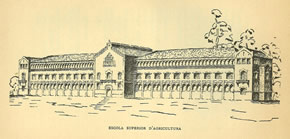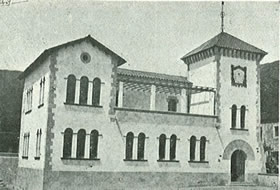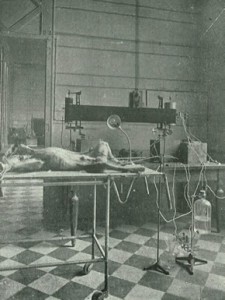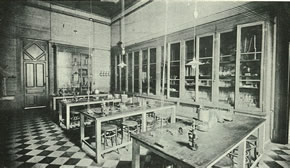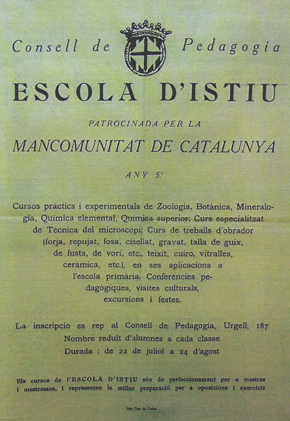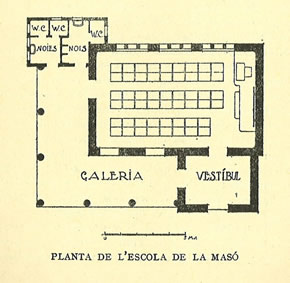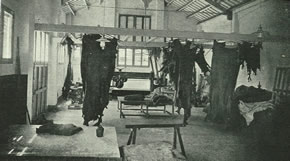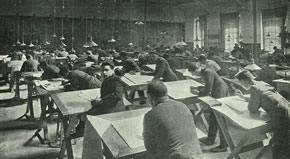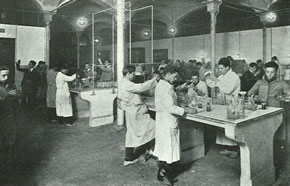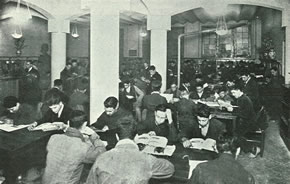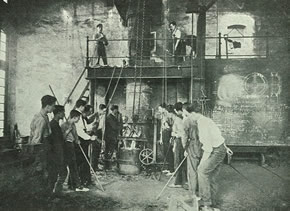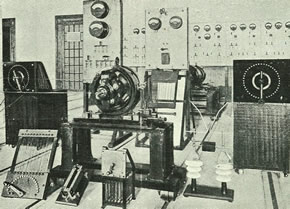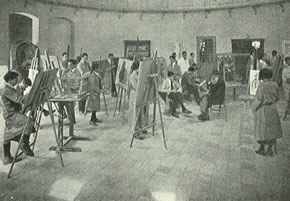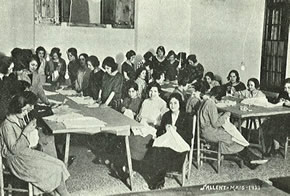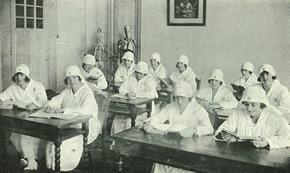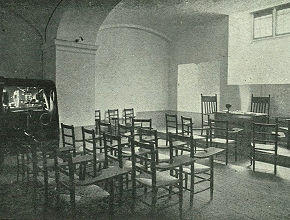Education for progress
The Spanish government understands education as a rigid, unwelcoming, strict thing—merely an administrative reality regulated by royal decrees, royal orders, and circulars. The Mancomunitat of Catalonia inherited the projects initiated by the Diputació under Prat de la Riba, and it committed clearly to a quality educational policy.
It had a wide range of offerings that can be divided into eight categories: higher education, school of education, elementary schools, vocational schools, business schools, art schools, people’s schools, and professional schools.
Higher Education
Higher Educations School
It was created by the Assembly on February 24th, 1921. Its goal was to provide the necessary means to give a proper education to college students and scholars who were interested in furthering their studies beyond elementary education.
Experimental Psychology Laboratory
It was established in November 1920 as an independent organization, but classes did not start until October 1922.
Pedagogy Seminar and Laboratory
Founded by the Institute for Catalan Studies on January 5, 1918. Initially, its activities were held at the facilities of the Montessori School, but later on it would move to Casa de la Maternitat (Maternity Ward), in order be able to make direct observations with the child population available there.
Physiology Seminar and Laboratory
It was founded by the Permanent Council of the Mancomunitat on July, 1920. By the April 13th, 1920 royal decree, it received authorization to relocate to the School of Medicine. It was inaugurated on April 11th, 1921.
Conferences and exchange courses
They started in 1915 at the initiative of the Diputació of Barcelona and the Pedagogical Council. Their goal was to expand educational opportunities through seminars by foreign professors, whether it was because that subject was not being taught in college at the time, or because the professors lived outside Barcelona.
School of Education
School of Education
It began its operations in 1919. At first, it offered a two year degree, and subjects were divided between obligatory (Catalan Grammar, History of Catalonia, Philosophy, and Pedagogy) and electives (History of Literature, Philosophy, Philology, Art History, Natural History, Geography, Chemistry). Later on, it became a three-year degree program.
Admission to teachers and high school graduates was free, but the minimum age was 17. At the end of the first three months, there was an eliminatory exam.
Summer School
It was intended for schoolteachers, special needs educators, clergy in educational missions, nuns from religious schools, education students, and mothers. They started in 1914. They would begin at the end of July and they would last practically for an entire month.
Elementary education
Montessori School
The Montessori School was created in 1915 by the Diputació of Barcelona. At first, it was located on Universitat Street, and later on it would be on Diputació Street. Two years later, it was relocated again and moved to the Grases estate. Although at first it was mostly a kindergarten, with the years it grew due to the needs of the parents.
School facilities
In 1915, the Permanent Council of the Mancomunitat agreed to build four new school facilities in Masó (Tarragona), Torms (Lleida), Sant Llorenç Savall (Barcelona), and Palau-Saverdera (Girona).
The Mancomunitat kept working on small school facilities for each one of the four degree tracks whenever it was possible. It considered large schools as a minor annoyance for cities. That’s why kindergartens were usually located near the center of towns, surrounded by gardens. On the other hand, higher education centers could be located on the outskirts.
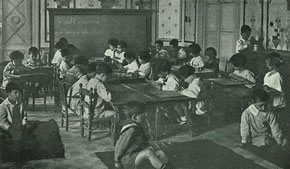
A class in the Montessori School .
Map of the Masó school.
School facilities at Palau-Saverdera
Photographs from the book L’obra realitzada: anys 1914-1923 / Mancomunitat de Catalunya (Works performed: Years 1914-23 / Mancomunitat of Catalonia)
Author: Mancomunitat of Catalonia
Year of publication: 1923
Vocational schools
Vocational School
In 1904 a fund for the school was created, and a year later, they would begin looking for the grounds.
School for Fabric Specialists
It offered instruction in the theory and practice of textiles in order to prepare them to be technical directors in production environments. It was located inside the University’s facilities, and the courses were divided into two sections, knitting and weaving technologies.
School for Bleaching, Dyeing, Stamping, and Sizing Specialists
It taught students so that they would be prepared to be in charge in a production environment related to any of these activities.
Tannery School
It began its operations due to a lack of technical knowledge of the directors and, also, before the decline of this sector. It was located in a 500 square meter building inside the Technical School. It offered a two-year degree. In order to apply, applicants had to be at least 15 years old and have passed the following subjects in any approved educational center: Grammar, Arithmetic, Algebra, Geometry, History, Physics, General Chemistry, French or English, and Technical Drawing.
School for Applied Chemistry
It offered instruction to professionals who would be in charge of establishing and developing the fledgling chemical industry in Catalonia, and to further grow the existing ones. On January 10th, 1915 classes began and weekly seminars were held related to these fields of study.
School for Electrical and Mechanical Directors
In 1917, the Diputació of Barcelona created the School for Applied Electricity as a joint venture with the School of Electrical Directors. Two years later, the School for Electrical and Mechanical Directors was born, as a part of the Technical School.
Requirements to apply to these two schools were exceedingly low, and no Math, Physics, or Chemistry was taught except for what was strictly necessary to work in one of the two careers. What was taught as the fundamentals in these degrees was the knowledge of how to organize a workshop, start a company, create an association to begin operations, and market research.
These two schools were located in two separate spaces of 930 square meters each. The first one had five rooms with mechanical labs, and the second one, four rooms , with electricity labs.
Guild School
It was the successor of the old Provincial Free Guild School, and it was connected to the Industrial Engineering School.
Machining and Metalworking School
- Machining instruction
- Instruction for foundry workers and modelers
- Instruction for furnace makers and technicians, and sheet metal workers
- Instruction for automobile mechanics
- Instruction for furnace and steam engine operators
- Typesetting instruction
Electrician School
- Instruction for electricians
Applied Chemistry School
- Instruction for dry cleaners, stampers, bleachers, sizers, and all other kinds of chemical industry operators.
Textile Industry School
- Instruction for supervisors, managers, technicians, and employees in textile factories, and for weaving assistants and supervisors.
Construction School
- Training for woodworkers and masons
- Body shop training
Language School (French)
Preparatory School
- Summer preparatory seminar
- Winter preparatory seminar
Exams and certificate
Students were supposed to pass final exams (revalidas) that certified they had been taught the subject, and with these they could obtain a certificate that showed their final grade and specialty. Before that, they received course certificates.
Additional benefits
Students who passed all subjects for the year were refunded the full amount of the application fee. Those who scored full marks in final exams received monetary compensation.
End of year trip
They sought to stimulate the students. In September, the school would organize these trips for those students who had deserved them.
Higher studies scholarships for workers
Starting in the 1920-21 school year, the Mancomunitat gave scholarships to all workers who had finished their studies and wanted to continue studying.
Library service
It was public and open on weekdays. In 1923, it had 3,000 available. It had seating capacity for 1,000 people.
Humanities seminars and conferences
On the one hand, during the months of July and August each year, specialized teachers taught seminars on art, science, sociology, etc. On the other hand, during the rest of the year, every Saturday afternoon there were readings of literature.
Vocational School Students and Alumni Association
Created in 1918, this association looked after the interests of workers who had done technical studies in order to help them find managerial positions adequate to their schooling.
Local Vocational Schools
Canet de Mar Local Vocational School for Textile Industries
Inaugurated on November 19th, 1922, in a building of their own, this school offered instruction to managers and supervisors for these industries. It also worked to educate its workers about their trade.
Badalona Municipal Vocational School
It started operations in October, 1915, and it organized classes for carpenters, masons, locksmiths, clerks, and seamsters. It contained the Badalona Textile School.
Although these were created before it, the Mancomunitat ended up being in charge of the following schools:
- Mataró Vocational School
- Vilanova i la Geltrú Vocational School
- Terrassa Vocational School
- Manresa Vocational and Agricultural School
- Sabadell Vocational School
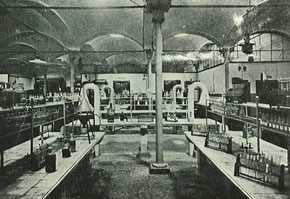
Applied Chemistry School—Analysis laboratory.
Tannery School
Textile Industries School — Knitting section.
Applied Chemistry School. One of the rooms for industrial inorganic chemistry.
Guild school. Drawing class.
Guild School. Lab practice for chemical industry workers.
Guild School. Library during study hour.
Guild School. Foundry clean up day.
Electrical Engineer School. Motors, control panels, and potentiometers built at the school.
Photographs from the book L’obra realitzada: anys 1914-1923 / Mancomunitat de Catalunya (Works performed: Years 1914-23 / Mancomunitat of Catalonia)
Author: Mancomunitat of Catalonia
Year of publication: 1923
Business Schools
Trade School of Business
Created by the Mancomunitat of Catalonia, it was inaugurated on November 3rd, 1918, and its goal was to educate teachers for the Local Business Schools. It also taught, among others, consulting specialists, stock brokers, accounting managers and directors, auditors, bank, company, and insurance clerks, customs agents, import and export experts, market specialists, transportation employees, postal service employees, consular corps officials, government accountants, worker, business owner, and cooperative secretaries, business directors, and entrepreneurs.
Local Business Schools
They were created by an agreement reached by the Assembly of the Mancomunitat in November, 1916. Due to irregularities with the distribution of the public contracts, the Permanent Council of the Mancomunitat canceled these, and it asked the Education Council to rewrite the public contract regulations to restart the process for the creation of two schools, each one located in its own building. This building would have its own student lab and office.
Art Schools
School of Arts and Crafts
Its main goal was to provide instruction for manual and art manufacturing workers. The project to create this school was approved by the Diputació of Barcelona on May 18, 1914, but it wouldn’t be until October 1st, 1915, when gardening, pottery, woodworking, and tapestry classes started.
Technical Arts School
Here they taught woodworking and metalworking. Classes began in the 1918-19 school year and they were mainly hands-on. They offered a four year degree.
Arts Academies and Arts and Crafts Schools
At first, they were regulated by an April 4th, 1891 agreement of the Diputació of Girona, but they eventually were transferred to the Cultural Services of the Mancomunitat of Catalonia. The schools that belonged to it were:
- Olot’s Fine Arts Academy
- Sant Feliu de Guíxols’ Fine Arts and Arts and Crafts Academy
- Palafrugell’s Fine Arts and Arts and Crafts Academy
- La Bisbal’s Fine Arts Academy
- Llagostera’s Fine Arts Academy
- Puigcerdà Fine Arts Academy
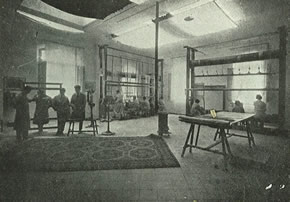
School of Arts and Crafts. Tapestry class.
School of Arts and Crafts. Drawing and coloring class.
Photographs from the book L’obra realitzada: anys 1914-1923 / Mancomunitat de Catalunya (Works performed: Years 1914-23 / Mancomunitat of Catalonia)
Author: Mancomunitat of Catalonia
Year of publication: 1923
People’s Schools
House Management School
It was created by the Diputació in 1919, and it worked towards spreading house management skills all over the country.
Technical School Extension Service
It originated from difficulties related to place of residency, availability of time, or age of the students. Classes were taught by mail and they were divided into six categories:
- Electricity
- Agriculture, Animal husbandry, Agricultural industries
- Construction
- Technical Drawing
- Workshop and factory organization
- Women’s studies
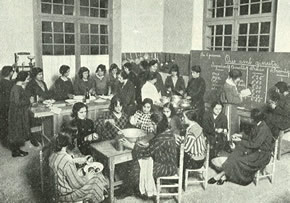
House management. Hands-on cooking in Canet de Mar.
House management. A seminar in Sallent.
Photographs from the book L’obra realitzada: anys 1914-1923 / Mancomunitat de Catalunya (Works performed: Years 1914-23 / Mancomunitat of Catalonia)
Author: Mancomunitat of Catalonia
Year of publication: 1923
Professional Schools
Nursing School – Medics
This project was approved by the Assembly in November, 1917. It was located inside the Technical School main building, for the theory lessons. Practice lessons took place at hospitals and health centers.
When the students passed two basic courses, they received their Nurse diploma, and later on, they could also go into one of the specializations being taught at the school in order to obtain a specialist degree.
Civil Servant School
It was inaugurated on March 2nd, 1914, with the name of School for Local Civil Servants. On February 16th, 1922, the Permanent Council of the Mancomunitat agreed to its creation, and it changed its name to Administration School, and it was relocated to Bisbe Street in Barcelona. Its main goal was to offer technical training to public servants.
As a complement to this school, there was the Municipal Museum, which was created as a result of seminar projects and ended up being an information center for everything related to town government. Additionally, there was also the Civil Service Library, which worked in conjunction with the other museum.
Women’s Professional School
It began operations in April, 1882, in the basement of the house at 49, Ronda Sant Antoni in Barcelona. It offered classes on sewing dresses and undergarments, decorative drawing and dress stamping lessons, and chemistry applied to clothing and its conservation.
In 1918, it changed its name to that of Women’s Professional School, and it would be located in 7, Carrer de la Ciutat, Barcelona, until 1922. After that, it changed location to 12, Carrer d’Elisabets, in the same city.








